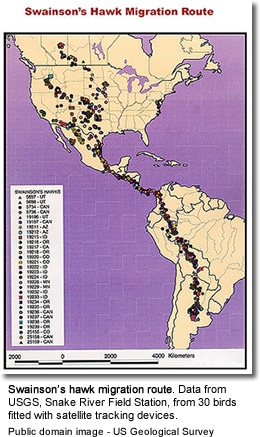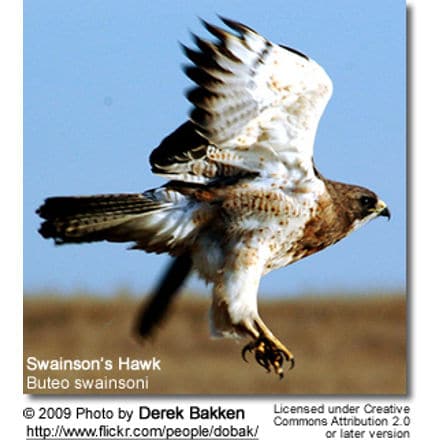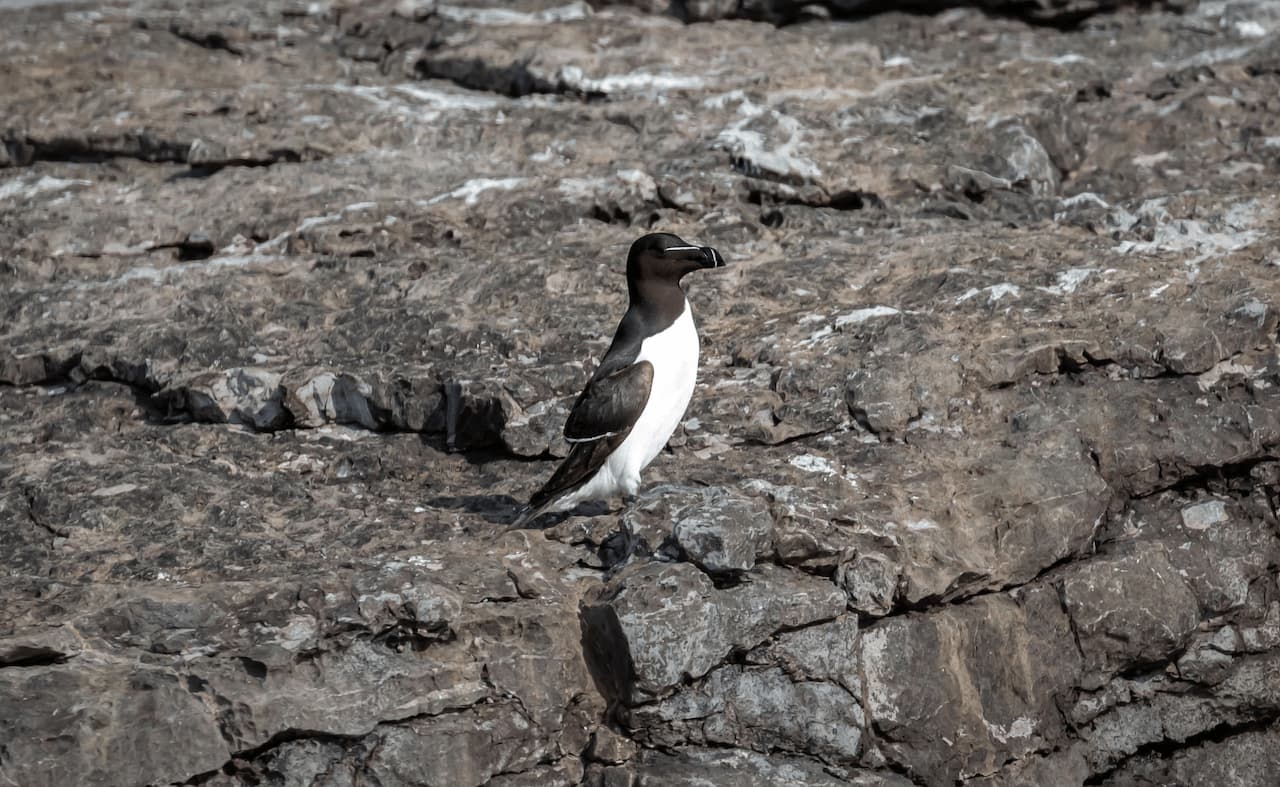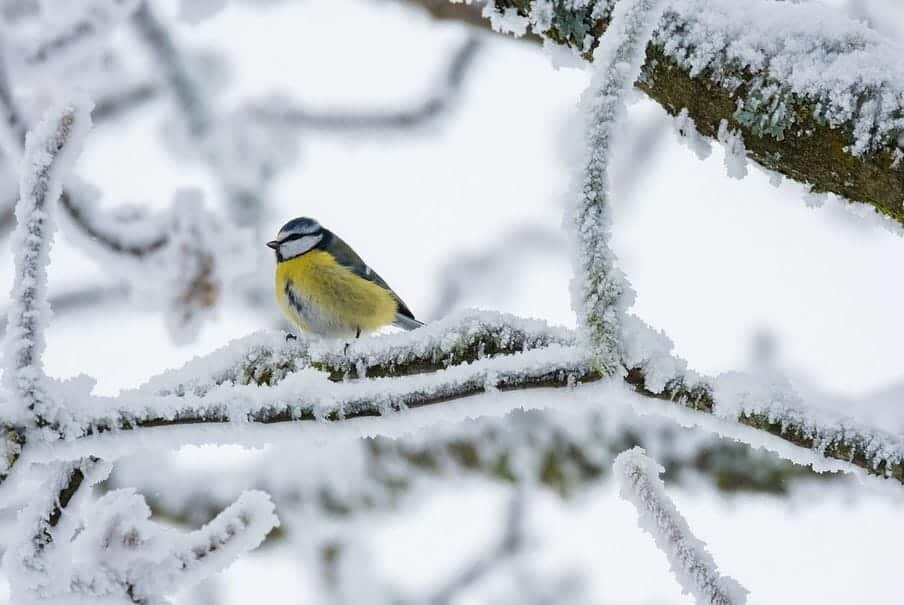Swainson’s Hawk or Locust Hawk (Buteo swainsoni)
The Swainson’s Hawk or Locust Hawk

The Swainson’s Hawk or Locust Hawk, Buteo swainsoni, is a large hawk.
Their breeding habitat is prairie and dry grasslands in western North America. They build a stick nest in a tree, shrub, or on a cliff edge. This species is a long-distance migrant, wintering in Argentina.
This bird was named after William Swainson, a British naturalist. In flight, they hold their wings in a slight dihedral; they tip back and forth slightly while soaring.
They are declining in some parts of their range due to loss of habitat. Although the use of DDT has been banned in the United States, the Swainson’s Hawk still encounters pesticide use when it migrates in the winter to Argentina. Known as the locust hawk, the hawks will eat numerous amounts of these insects and in turn ingest a high amount of toxin, which causes the thinning of eggshells.
This species or its immediate precedessor is the ancestor of the Galápagos Hawk, as demonstrated by recent research. The latter diverged from the mainland birds perhaps 300,000 years ago, a very short time in evolution (Bollmer et al., 2005).
Distribution
The Swainson’s Hawk is a common bird of the western plains of North America. It is one of the most highly migratory of all North American hawks, leaving its breeding grounds in the fall to winter in the pampas of South America. In a life span of seven or eight years, a Swainson’s hawk might cover as much as 15,000 miles (24,000 km) during its migrations north and south. See the migration route map of Swainson’s Hawks below.
The Swainson’s Hawk is a slender raptor slightly smaller in size than a Red-tailed Hawk. However, the Swainson’s Hawk has a slightly longer wingspan and slimmer wings than other soaring hawks. A common color pattern for the adult Swainson’s Hawk is dark brown plumage with a brown chest and a pale belly.
In flight, the Swainson’s Hawk holds its wings in a shallow “V” dihedral and teeters in flight a little like a Turkey Vulture. The long, slim, pointed wings are diagnostic when they show the two-toned effect of pale wing linings and dark flight feathers. No other buteo shows such consistently dark flight feathers.
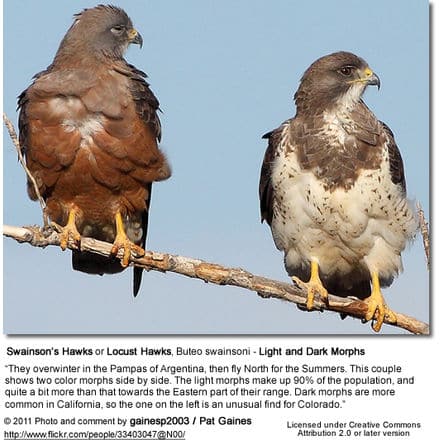
Identification Tips
A general color pattern for soaring hawks when viewed from below is dark feathers on the leading edge and lighter feathers on the trailing edge of the wings. However, the Swainson’s Hawk can be distinguished by the opposite coloration; light leading edge and dark trailing edge. The adult will have a pale body with a dark “bib” on the chest and a noticeable white throat patch.
There are two main colour variations (morphs or genetic mutations):
- Light morph birds are white on the underparts and underings; they have a grey tail with dark bars and a reddish breast. Their head is brown with a white patch on the chin.
- Dark morph birds are dark brown except for a light patch under the tail. There is a rufous variant that is lighter on the underparts with reddish bars.
Perched Swainsons will have wings that extend to the tip of the tail or beyond. A light-colored belly sometimes barred, especially on flanks; brown back and upper wing surfaces; a gray-brown tail with about six narrow dark bands and one wider subterminal band.
Habitat
The habitat of the Swainson’s Hawk consists of open and semi-open country in both its breeding and wintering ranges. In North America, it is found in the southwest deserts, grasslands and prairies of the intermountain states and provinces, and the grasslands of the Great Plains. Swainsons require trees for nesting and are found around aspen groves, riparian areas, and farmlands.
It favors wild prairie, hayfields, and pastures over wheat fields and alfalfa fields which may offer its prey too much cover. It requires elevated perches for hunting and a supply of small mammals such as young ground squirrels as prey for its nestlings. The breeding distribution of the Swainson’s hawk is tied very closely to the distribution of various small mammals for this reason. In Saskatchewan, for example, the distribution of Richardson’s ground squirrel and the Swainson’s hawk are precisely the same.
The winter migration of the Swainson’s Hawk is an incredible sight. They migrate overland in vast flocks that fill the skies with birds and the viewer with awe. From North America through Mexico and Central America to wintering grounds in Argentina, this annual trip may range from 11,000 to 17,000 miles. The wintering grounds are the open pampas of southern South America where immatures nomadically follow hordes of migratory dragonflies.

Range
The Swainson’s Hawk inhabits North America mainly in the spring and summer and winters in South America. Breeding areas include south-central Alberta, central Saskatchewan, southwestern Manitoba, and west and southern Minnesota. They will breed as far north as east-central Alaska, and southwestern Yukon. Breeding continues south through the eastern parts of Washington and Oregon, locally to the central valley of California, Arizona, New Mexico, and most of Texas. The eastern part of its range includes Minnesota, northwestern Iowa, most of Nebraska, Kansas, and Oklahoma, and all but eastern Texas. It periodically occurs in Iowa and rarely in northwestern Missouri, northern Illinois, and southwestern Wisconsin.
Small populations winter in southeastern Florida and along the Texas coast, probably having failed to find the way south around the Gulf of Mexico. Individuals reported, for example, that Christmas Bird Counts north of these areas are almost invariably misidentified buteos of other species. Immature Swainson’s hawks winter on the pampas of South America in Argentina, Uruguay, and southern Brazil. It is not known with certainty where most of the adults spend the winter.
The Swainson’s hawk appears to feed during the early part of fall migration but not the later stages. It is reported that Central American migrants do not feed or cast pellets. The Swainson’s hawk is probably the longest long distant migrant of any North American raptor. The flight from the breeding ground to South American pampas in southern Brazil or Argentina can be as long as 14,000 miles (22,400 km). Each migration can last at least two months.
Hawks leave the breeding grounds from August to October and gradually head southwards toward Central America where virtually the entire population funnels through the Isthmus of Panama. Concentrations over locations like Ancon Hill, Balboa, and Panama are spectacular.
Fall migration begins each clear day on which a wind blows in the general direction of travel. Birds gain altitude by soaring in circles on a rising thermal and then setting their wings and closing their tails as they glide, slowly losing altitude until they find another thermal and rise with it. Thus, waves and small groups are strung out across the sky.
Spring migration broadens once the birds have passed through Mexico as they disperse through the breeding range. Migrant groups were noted in the southern states in March. The earliest Swainson’s hawks arrive in southern Canada in late March with migration peaking from mid-April onwards.
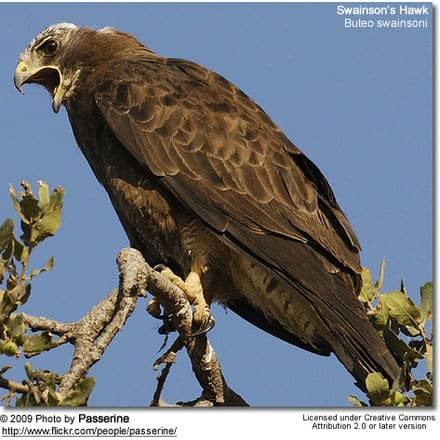
Behavior
The Swainson’s Hawk soars over open ground with wings held in a dihedral. It occasionally courses low over the ground like a harrier and may hover like a Rough-legged Hawk. The Swainson’s Hawk commonly perches on the ground both during migration and on the breeding grounds. During migration, it typically roosts for the night on bare ground with scattered trees, a habit that distinguishes it from fellow long-distance migrants such as the Broad-winged Hawk, which roosts in closed canopy woodlands.
A hunting Swainson’s Hawk will use several strategies. It hunts insects, such as dragonflies or dobson flies while in flight, flapping little as it rides a wind current and stoops upon a fly, grabbing it with its foot and immediately transferring the prey to its bill. It uses a similar strategy to grab individual free-tailed bats from flying streams of bats. Also, when dragonfly hordes are grounded by weather, the Swainson’s Hawk will stand near groups sheltering from the wind and pluck at individual insects. The Swainson’s Hawk closely follows both tractors and wildfires for injured or fleeing food. It will also run down insect prey on the ground. Occasionally a hawk will stand still on a dirt bank or elevated mound waiting for prey to appear. It commonly hunts from elevated perches such as telephone poles, stooping on prey when it’s sighted.
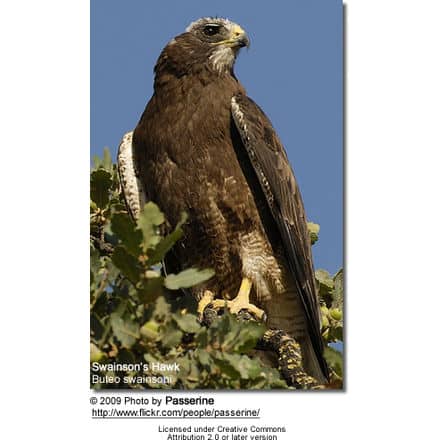
The Swainson’s Hawk will defend its territory from other buteos. Breeding densities may vary from one area to the next but averages one pair per 2.5 square miles (6.5 km²). The average home range estimate for this hawk is 1 to 2 square miles (2.5 to 5 km²). The Swainson’s Hawk gathers in groups for feeding and migrating. However, in each case, such gathering is not social, but motivated by good feeding or migrating conditions.
The Swainson’s Hawk, Red-tailed Hawk, and Ferruginous Hawk compete for territory and defend territories against each other. In many parts of the plains, these three species nest in the same general area and exploit much the same prey base. Although diets overlap greatly, habitats may not overlap as much. In Oregon, the Swainson’s Hawk selects nesting trees having a different configuration than those used by Red-tailed or Ferruginous Hawks. In southern Alberta, different nesting habitats help reduce food competition, with the Swainson’s Hawk favoring areas with scattered trees or riparian borders, while Red-tailed Hawks nest in stands of tall trees, and the Ferruginous Hawk nests on the open plains.
Reduced reproductive success may result from the Swainson’s Hawk’s nesting proximity to these two other buteos. The Swainson’s Hawk is generally tolerant of people. The bird is attracted to haying, mowing, and ploughing operations. House Sparrows, European Starlings, and other small birds may nest in, or near a Swainson’s Hawk’s nest.
Nesting
When Swainson’s Hawks arrive at their nesting sites in March or April, they may return to their original nests as these hawks are noted to be monogamous. Research indicates that they have a high degree of mate and territorial fidelity. This is an unusual occurrence in a long-distance migrant. Seven to 15 days after the birds arrive, the males begin constructing nests on the ground, ledges, or in a tree. The nest consists of twigs and grasses and can take up to two weeks to complete. New nests may be constructed, old nests refurbished, or the nests of other species, including those of Common Raven, Black-billed Magpie, and American Crow, refurbished.
Swainson’s Hawks typically nest in isolated trees or bushes, shelterbelts, riparian groves, or around abandoned homesteads. Occasionally, a pair will nest on the ground or a bank or ledge. Nest trees and bushes include ponderosa pine, Douglas-fir, spruce, cottonwood, domestic poplar, aspen, elm, mesquite, willow, saguaro cactus, and soaptree yuccas. Nests are located from nine to 15 feet above the ground, often in the shaded canopy but near the top of the tree. Nests are flimsy structures, usually smaller than the nests of the Red-tailed Hawk, and often blow down after the nesting season.
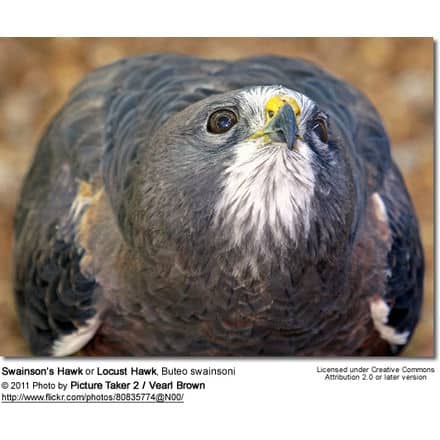
Food/Diet
These birds patrol open areas or scan for prey from a perch; they may also catch insects in flight. They take advantage of insects turned up by farm equipment or driven out by fire.
The Swainson’s Hawk may be largely insectivorous except when nesting. Insect prey commonly taken includes grasshoppers, crickets, and locusts. Pairs bring vertebrate prey to their nestlings, relying heavily upon small mammals such as young ground squirrels, young cottontails, pocket gophers, mice, young jackrabbits, and, at least locally, small birds and other vertebrates including reptiles and amphibians. Birds taken include large birds such as Mallards, and Sage Grouse which may have been injured initially.
Other unusual bird species taken include American Kestrel and young Short-eared Owls. More typical in size are young Lark Buntings taken at their fledging time. Reptiles, which can comprise large parts of a diet, include snakes such as racers, gopher snakes striped whipsnakes, and lizards. Amphibians may include tiger salamanders and toads. The Swainson’s Hawk is an opportunistic feeder that responds quickly to local concentrations of food. Its habit of gorging on outbreaks of crickets and grasshoppers has earned it the popular name “Grasshopper Hawk”.
In Argentina, flocks of immature Swainson’s Hawks feed on flocks of the migratory dragonfly Aeshna bonariensis, following the hordes of insects and feeding mostly on the wing. Local outbreaks of locusts may also be exploited for food by one or more age classes of birds. The immatures wintering in southern Florida feed upon either insects, mice, or both when turned up from field ploughing. They move from one freshly ploughed field to the next.
There is also some evidence that road-killed birds and animals are also consumed both on the wintering grounds and on the breeding grounds. The species commonly follow tractors and other agricultural equipment during haying or ploughing, where rodents are exposed for the hawks to capture, or insects are uncovered after crop cutting. The Swainson’s Hawks have been known to hunt the edges of prairie wildfires.
Voice
Outside the breeding season, the Swainson’s Hawk is a rather silent species. During summer the most common vocalization is a shrill, aggravated-sounding “kearrrrrrr”, weaker than the similar call of a red-tailed hawk. The voice of the females is lower pitched than the males. This call is given when people approach the nest and in other aggressive encounters.
Reproduction/Life Span
The courtship displays of the Swainson’s Hawk are not well known. One activity involves circling and diving above a potential nest site. The underwings and rump are flashed and the birds call. The display may end with one bird diving to land on the edge of the nest. Copulation occurs mainly in the morning and evening on the dead limbs of trees. The female may assume the receptive position without a prior display. During treading one of the birds calls.
Clutch size ranges from one to four eggs, but averages two to three eggs. Each egg is elliptical about 2.25 inches (57 mm) long and 1.8 inches (46 mm) wide. The egg is smooth with fine granulation and the ground color is white, often tinted bluish or greenish. During incubation, the shell color quickly wears to dull white. Some eggs are plain; others are lightly marked with spots and blotches of light brown. The incubation period is 34 to 35 days, with the female incubating while the male brings food.
Young Swainson’s are fed small, young mammals. Flight feathers begin to emerge on the young at nine to 11 days. High nestling mortality often occurs when the young are 15 to 30 days old and may be a function of fratricide. The young begin to leave the nest for surrounding branches at 33 to 37 days, fledging occurs at about 38 to 46 days. The fledglings are dependent upon their parents for four to 5 weeks. This species has one brood a year and does not lay replacement clutches.
The oldest wild Swainson’s Hawk on record is 15 years 11 months. Swainson’s Hawks die because of collisions with traffic, illegal shooting, electrocution, and even during severe prairie weather such as hailstorms. Wind storms and hail caused 30 percent nest failure in one study. When sharing a grove with nesting great horned owls, hawks suffer much egg loss due to owl predation. The species also suffers from frequent, unexplained egg infertility.
Conservation
The Swainson’s Hawk has suffered population declines since the first half of the century and was Blue-listed in the United States from 1972 to 1982. It has since been placed on the National Audubon’s List of Special Concerns in 1986. It is now listed by the United States Fish and Wildlife Service as a Category 3C candidate. It should be noted that the Swainson’s Hawk was removed from the active Federal list because it was found to be more abundant than previously thought. It remains listed as a threatened species by the California Department of Fish and Game as it has been since 1983.
A major cause of Swainson’s Hawk population decline was pesticide use in its wintering grounds in Argentina. Farmers there were using pesticides to control grasshopper infestations and the Swainson’s Hawks were ingesting these pesticides in several different ways. The U.S. has worked with Argentine farmers to resolve this problem.
The Swainson’s Hawk has adapted well to grazing and pastureland and seems to be holding its own over much of its breeding range, from northern Mexico to the southern parts of the prairie provinces. However, far western populations, like that of Oregon, and southern California, have drastically declined, often due to habitat loss or incompatible agricultural practices. A possible reason for declines in parts of its range may be agriculturally motivated reductions in populations of both ground squirrels and grasshoppers; major seasonal foods.
Although often nesting close to human activity, some Swainson’s Hawks are very easily disturbed at the nest and often desert, especially early in the season. The bird is often quite tame and remains an easy target for shooters traveling isolated prairie roads. The species may also be affected in ways yet to be understood, by some insecticides and herbicides, including those used on its wintering grounds (Goldstein et al. 1996).
Observing Swainson’s Hawk
One of the best places to view the hawk is in the Snake River Birds of Prey National Conservation Area (NCA) in Idaho. Birds in the NCA are not on display. They follow the rhythms of nature and not the desires of people who come to see them. Your chance of seeing the falcons will improve if you follow these tips:
- Bring a good pair of binoculars. Field guides or spotting scopes are also helpful.
- Viewing tends to be best in mid-March, May, and June, in the early morning and evening hours when the hawks are actively hunting.
- During April, viewing opportunities slow as birds spend most of their time sitting on nests.
- By July, the canyon temperatures are fiercely hot, ground squirrels have gone back underground and many birds of prey have left the area.
- Wildlife are wary of humans. Patience is a wildlife watcher’s best virtue. When an animal changes behavior as a result of your presence, you are too close.

